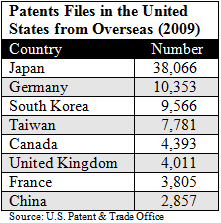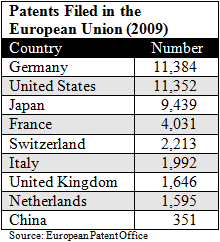Goodbye Old Tech Government, Hello New Tech Government
Op-Ed Commentary: Chris Devonshire-Ellis
Oct. 11 – A fascinating aspect of China business right now is where to spot the next trends. The country is continually evolving, and with an over dependence of exports, it needs to move up the added value chain.
In fact, it’s doing more than just that. China is investing some serious money into high technology and innovative products across a multitude of disciplines. I covered part of these in my recent piece on new China Innovation, which was followed up by an analysis from my colleague Andy Scott on Cleantech. Everything is moving in China, from GM, biotech, alternative energy, pharmaceuticals, even space technologies, a lot of cutting edge research is being conducted by China’s institutes, R&D bodies, universities and businesses. The brave new world is being born before our very eyes.
Yet doing business in China, especially in these new, developing industries, is going to happen in a manner not previously attempted, and foreign investors are going to need to adapt to the new parameters. This has to do mainly with the way in which China has organized itself structurally. Everyone is familiar with China being a one party state. Yet commercially, the impact is the same. About 90 percent of China’s largest companies are either partly or wholly owned by the government. When, for example, the government announces it is going to invest US$700 billion over the next 10 years into alternative energy that money isn’t going to go very far away from the purse strings. It’ll be invested in state owned R&D centers, institutes, university funding, and when commercial applications can be found, into businesses that will also be state owned.
The implications for high-tech, cutting edge foreign investors are huge. China doesn’t even need the investment dollars these days in many businesses (although certain sectors still require billions of dollars in research). What China wants is the technology and expertise that already exists overseas, and to try and marry that up with Chinese know-how, avoid duplication, and truly usher in a new century of new technologies. What will become important however is a shift in the dynamics of how businesses in China are viewed in this new dynamic sphere of innovation. Foreign investors, more than ever, are going to have to consider the political implications of dealing with a company that is represented by another nation’s government – and one that in some quarters is still regarded as “unfriendly.” China itself is also going to have to adapt to meet its needs.
Political risk in new industries will become more of an issue than in the past, as will an overall understanding over exactly which bit of the government is responsible for your particular industry. Without that road map, it will be next to impossible to work out who your partners really are. Non-possession of that key piece of information means you fail to develop an understanding of the “corporate culture” or the dynamics behind a venture. It’s not guanxi, it’s knowing who you’re dealing with and it’s a sensible question to ask and to research. Within this, there are issues concerning ongoing matters of bribery and so forth, as the qualifying distinction between who is a Chinese businessman and who is a Chinese official become hazy, which is an aspect the U.S. Foreign Corrupt Practices act focuses on but this article is not intended to explore that avenue.
Rather more, the exciting element of investing in China in such industries is that China does in fact need all the help it can get – in some cases financial but, in the majority, technological. China has already introduced incentives for “foreign experts” to work in China and the door for overseas participation is undoubtedly open. Incentives in “encouraged industries” investing in high-tech and even tax breaks are available to the foreign investor in many areas of primary and secondary research. That participation, though, needs to be as transparent as possible. Foreign investors, especially those with cutting edge technologies, are not going to be falling over themselves to invest in China unless the end game (patent ownership either jointly or severally) can be guaranteed. Already, when working on research leading to patented inventions, care needs to be taken and professional advice sought from China based lawyers with plenty of in-country experience. At the top end, and cutting edge, China is reasonably well behaved when it comes to honoring its agreements; however such commitments from the investor do need to be put in place first and professional advice taken. There is plenty of money to be made from future technologies, and with China currently leading the world in new patent applications each year, it’s a fertile market. Yet what is interesting is to compare the national origins of countries filing patents in the United States and the European Union as an indicator of where technologies are coming from, and where they are being developed.


The message is clear. While China does indeed domestically process a large number of patents each year, very few to date have been registered in overseas markets, meaning Chinese businesses are still catching up with claiming rights with applications purely within their own borders. Some of these may well be worthwhile exploring to see what can be viewed as truly innovative that would have global commercial implications. The records are available. Additionally, it demonstrates that China still lags behind as a global innovator, and does indeed need technological assistance. The downside is that China is largely untrusted when it comes to the development of R&D and the granting of patents globally that are of Chinese origin. Accordingly, much Western-funded research in Asia is conducted in Japan, Taiwan and South Korea, where secrets are better protected, there is less government involvement in business, and more appreciation that to innovate, designers need to be rewarded with a patented acknowledgement of their intellect. This also applies to foreign partners working with their Chinese counterparts, who aren’t there “just to help” but are an equally valid part of the innovation process. Without assurances over recognition, they will remain in Korea, Japan and Taiwan. The innovation aspect of China moving up the added value chain is something China stands to lose if it cannot get the annoyance of IP infringements out of its system. That’s easier said than done, with powerful mechanisms (such as the military) behind much counterfeiting of Louis Vuitton bags for example. But for every fake LV bag sold, China loses a potential partner that could provide technologies in far more necessary intellects.
China’s challenge is to match the need for new technologies with a safer operating environment to protect foreign investors working in China to create new inventions. I believe that is slowly happening, and that opportunities exist. However, a sound patent lawyer is required, as are concrete agreements, and a mutually beneficial platform from which the financial resources the Chinese government are putting into new technologies needs to be supported by protection of inventions and unique designs. If interested in the China market, the ability to negotiate with government, and with the patent laws, and develop trust in both needs to take place. China still has a long way to go to win overseas investor trust if it is to succeed. Investors, meanwhile, may want to spend time assessing what innovation is already extant, and potentially worthwhile, while keeping an eye on obtaining security from patent applications in the country. If China cannot securely deliver in this area, development will stay exactly where it is – in secure, friendly Asian facilities and R&D centers, in the West, and China’s growth towards added value and innovation will take rather longer than expected.
Chris Devonshire-Ellis is the principal and founding partner of Dezan Shira & Associates, establishing the firm’s China practice in 1992. The firm now has 10 offices in China. For advice over China strategy, trade, investment, legal and tax matters please contact the firm at info@dezshira.com. The firm’s brochure may be downloaded here. Chris also contributes to India Briefing , Vietnam Briefing , Asia Briefing and 2point6billion
The practice does not provide advice over filing of patents, but is able to recommend suitable law firms in China possessing the relevant expertise.
Related Reading
Trademarks in China – Registering in English and Chinese Characters

Intellectual Property Rights in China
Our complete guide to IPR in China, applications, protection, enforcement and litigation; 60 pages; US$25 (hard copy) US$40 (PDF)
- Previous Article New FCPA Office in San Francisco – China Being Targeted
- Next Article Shanghai’s New Qingcaosha Reservoir to Open this December









